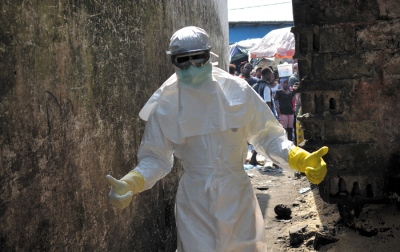Do you know one of the advantages of being an engineer turned biotechnologist turned entrepreneur/capitalist? You can write a blog like the one below.
A few months ago, I was in an event that discussed approaches and challenges in tackling Ebola, organized by the MIT Enterprise Forum of Cambridge.
Many such sporadically emerging diseases of global consequence needing rapid efforts to containment (like Ebola, Anthrax, Bubonic Plague) share the same trait, that their occurrence happens unexpectedly, the effect is deadly and spread is rapid, and it does not always attract enough funds to do lot of research or stockpile vaccines/cures, like two classes discussed below.
The discussion in the above event boiled down to three technical topics, and need for lots and lots of money (double digit billions of US dollars) to stockpile the vaccines. (when vaccine(s) is used alone in this blog – please read as vaccines/cures)
- Design of better suits and other tools to protect care givers.
- Immune based vaccines (antigen-antibody approach).
- Nucleic acid based vaccines (like antisense and RNAi).
Improving protective gears:
The first topic centered on using engineering, advances in material science and user interaction sensitive design. Among other topics, involving places like MIT towards this problem was discussed. I think we can also tap talent using hackathons, like Hacking Pediatrics or MIT Hacking Medicine. I am using these two because I happened to be there as mentor in recent hackathons.
Immune based vaccines:
Immune based vaccines for non-biologists, is to identify ways to elicit natural/artificial immune response (antigens/antibodies) through rigorous research from infected individuals that show resistance or from appropriate model systems. Certainly it takes effort, expense and time to identify them. So it makes sense to invest in research to test out effective vaccines continuously and keep the best one as the first line of defense.
Nucleic acid based approaches:
An example of Antisense technology is (e.g., identify potent nucleic acids that will bind to DNA/RNA viruses and inactivate their capability to replicate) and was represented by the company Sarepta Therapeutics in that event.
RNAi (RNA interference) is a mechanism to degrade the viruses, may even be possible to use strategically against bacterial pathogen infections – the discussion of that is beyond the scope of this blog. An example company, that was also represented in that event, is Alnylam Pharmaceuticals. My interests and success in predicting things of very high consequence with RNAi are highlighted towards the end in this other blog.
A third class that was not discussed is the emerging approach to deliver RNA molecules into appropriate cells and express proteins, and an example of such company is Moderna Therapeutics.
Here, again, it makes sense to invest in research to test out effective vaccines continuously and keep the best one as the first line of defense.
Much of the discussion, except for what I brought up as a question in between, discussed using lot of money to stockpile these vaccine candidates.
My question which is also my suggestion in this blog relates to research and improving existing capabilities for Just In Time (JIT) manufacturing for these vaccines, rather than building a stockpile with huge expense – some other disadvantages are highlighted below. This term JIT has been very popular in engineering manufacturing industries, initially became popular in automobile industry when Japan took a significant lead over American automobile manufacturers – and is one of the focus of many Operations Management or Operations Research (OR) studies – so as to reduce having inventory which increases the cost of the whole process and the end product (e.g., a car).
The advantage of a person like me who is an engineer turned biologist turned entrepreneur/capitalist who has been trained and been in many fields with deep experience in life sciences – including infectious diseases click here to see a futuristic framework – come in the above statement. Borrowing the idea from engineering, we should simply invest in improving manufacturing systems and identify locations/companies to manufacture antibodies, antigens or nucleic acid (which is relatively simple – except there is currently no major need to manufacture them at such large scale, yet).
Our funding agencies like NIH, NSF, CDC and other foundations (e.g., the Bill and Melinda Gates Foundation) and health and welfare organizations like WHO, UNICEF etc. should focus and incentivize research groups, pharma and biotechs or even other enterprises outside healthcare sector to contribute to improving rapid production techniques – be it using recombinant cell lines, other isolated cell lines like hybridoma, or approaches taken by companies like Genocea, or even from microbes (bacteria, yeast, fungi) and bioprocess equipment like fermenters/bioreactors for large scale or continuous cultivation and downstream processing – and manufacture enough when need arises.
Thus we do not stockpile vaccines/cures for these sporadic diseases (that we do not know when or if it is going to arise again) and also avoid the risk of stockpiling older generation vaccine/cure in large quantities for unknown amount of need. That way (i) we can scale up latest available vaccines/therapeutics when need arises and very rapidly, and (ii) manufacture the latest generation vaccine/cure when such sporadic and catastrophic diseases strike.
Another concept that is popular in operations management and supply chain management is “buffer or suffer”. Simplistically, in order for a process outcome to be effective we identify bottlenecks and initial needs to store just enough quantity of the materials or the end products to suit the need, rather than optimizing only resource utilization. Naturally, this concept applies here as well. We should stockpile just the buffer amount of vaccine/cure that is the best proven solution at any point in time.
To summarize the solution proposed in this blog in a simplistic sense of the concept:
- We invest in research just to identify and improve vaccines/cures for such diseases, but not to stockpile huge quantities.
- Invest/incentivize other enterprises to improve JIT production of the vaccines/cures – which infrastructure can usually be used for lot of other purposes, so the infrastructure won’t be sitting idly.
Implementing this takes getting people from all sectors to work together and as separate subcommittees and formulate the plan. Biologists, healthcare, epidemiologists, user experience specialists in these arenas, engineers for design of equipment as well as protective gear, operations management specialists, people with ground experience in delivering this in all kinds of societies and policy makers together with people who are responsible for funding will all be involved in this process.
Share your thoughts in the comment section below, or if you are not a person who likes to share your thoughts use these suggestions as well as come up with your own to ‘Build an efficient and healthy world’.
*Picture from Nature magazine, with permission.


One thought on “Just in time (JIT) vaccines and cures for Ebola and other sporadically emerging (and devastating) global infectious diseases”